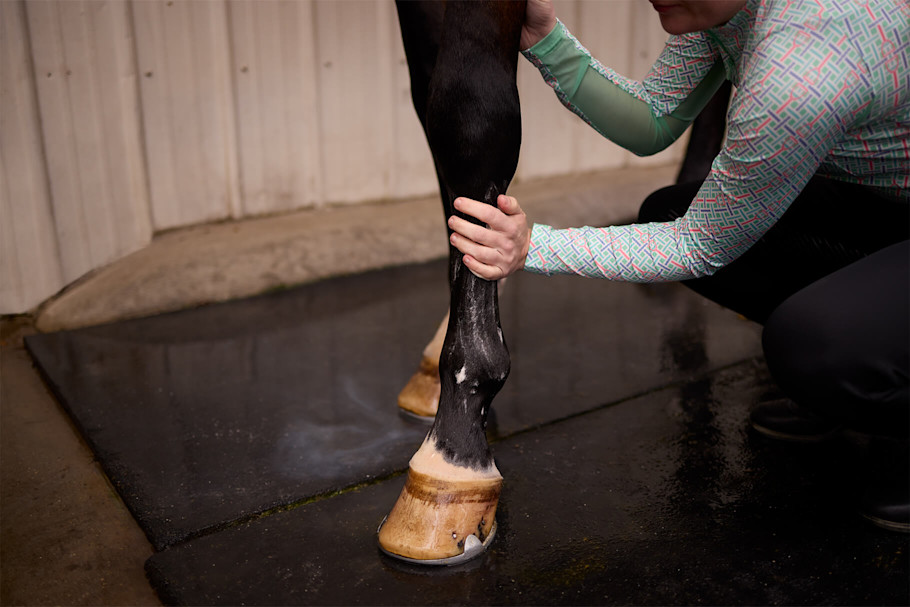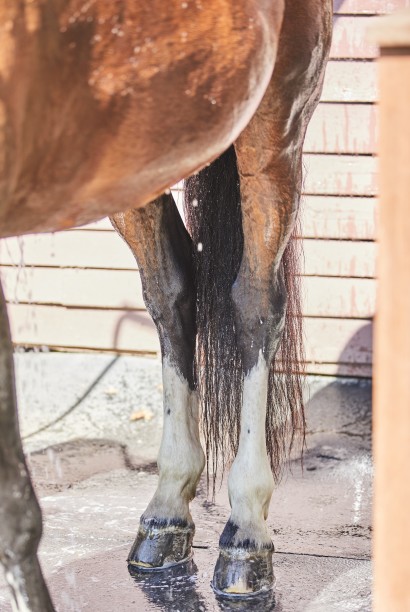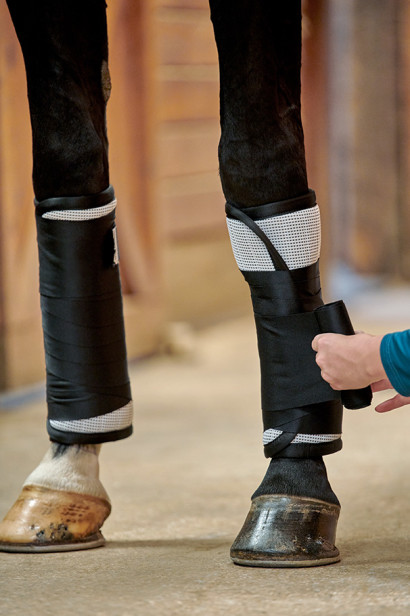Washing and Wrapping a Horse’s Legs in Hot, Humid Weather
By: Liz Schatz, DVM | Updated July 15, 2025

Whether for protection during travel, support after exercise, or wound care for an injury, horses often need to have their legs wrapped. Many equine athletes across disciplines wear standing bandages every night while in their stalls. When coupled with intensely hot and humid weather, continually wrapped legs are at more of a risk of developing bacterial and fungal skin infections.
Preventing both stocked up legs and the dreaded fungus can be quite a balancing act, even in ideal weather. So, during the hottest months of the year, it is even more crucial that riders understand how to properly wash, dry, and bandage their horse’s legs to keep the skin in its best possible condition.
Limit Use of Soaps and Shampoos

Horses’ legs are often washed and cleaned to prevent or manage skin issues. However, it is important that bathing with soaps and shampoos is not done too often, particularly if you are using medicated shampoos.
Veterinarians tend to recommend using these medicated products no more than twice a week. Similarly, regular shampoos should not be used every day, if possible. Both standard and medicated shampoos will pull the natural, protective oils out of the skin. If used too often, this can leave the horse’s skin dry, damaged, and more prone to infection.
Rinsing the legs with only cool or warm water is a good alternative to remove mild mud, sweat, and other debris.
Excessive moisture may negatively affect hoof health
Being strategic about how often you rinse or bathe your horse can also impact hoof condition. Excessive moisture may lead to issues like flared hoof walls, cracks, flattening of the sole, or a softer hoof that is more prone to losing a shoe. Reducing the number of times your horse is being rinsed down in the wash stall can help keep the hoof wall healthy.
Thoroughly Dry Your Horse’s Legs After Washing

After washing your horse’s legs, use a clean towel to remove the bulk of excess water and then allow them to air dry as much as possible. Hand grazing your horse or standing them in front of a large barn fan are great options to encourage faster air drying, too. The goal is to minimize the amount of moisture on the legs before stable bandaging.
If you typically rinse your horse in a wash stall, once you have scraped the water off their coat, try to move your horse to a different set of cross ties so that their hooves are on dry matts, if available.
Using baby powder, gels, or ointments
Baby powder or other gentle, powdered skin products are often used to absorb small amounts of moisture prior to bandaging. However, if these powders are used when the skin is too wet, they will form a clumpy paste that may cause irritation when left under bandages of any kind.
If medicated skin gels or ointments are needed under leg wraps, they should be used in the smallest amount possible to treat the issue once the legs are dry. Again, this will minimize the amount of moisture on the skin, reducing your horse’s risk of irritation or other issues like fungal infections. As always, follow your veterinarian’s guidance with any medicated products.
Choose the Right Type of Leg Wraps

There are many leg wraps for horses available, which can sometimes feel overwhelming.
For shipping purposes, a pillow or quilt wrap with either a traditional standing bandage or flannel bandage over the top are good options. Flannel bandages tend to keep the legs slightly cooler, but they do not offer the elasticity of polyester standing bandages. Some owners prefer shipping boots for trailering, which are particularly useful if hock protection is needed.
For standing wraps, the no-bow wraps may provide a bit more limb support than thick quilt or cotton wraps. No-bows are a thinner material that can be compressed more than some other types of wraps. Another option are quick wraps, which may be a great choice for those not as comfortable placing standing bandages (but these are not appropriate for every situation).
When in warm climates, you may want to find wraps that use breathable, moisture wicking fabrics, such as bamboo. Whatever leg wraps you choose, make sure you are comfortable applying them or find a trusted horse person in your network that can assist. Additionally, any protective leg wraps or boots are recommended to be used when your horse can be safely monitored in a confined area, like their stall.
How often to rewrap legs in hot weather?
Traditional standing wraps should be reset at least once per day. This accounts for any mild slippage and gives you a chance to look at the legs and assess any issues. However, if you notice strike-through bleeding or if the bandages are dirty, wet, or have slipped, then they should be taken off immediately and reset regardless of how long they have been on your horse.
Having clean, dry, and properly set leg wraps ensures the best environment for your horse’s sensitive skin and the underlying tissues and structures in the limb.
Other Considerations in Extremely Hot, Humid Weather
Convection (air cooling) is the way the tendons and ligaments of the legs naturally cool off. Despite the positive effects or necessity of any protective leg boot or wrap, these tools can hamper this ability for a horse’s legs to cool down. During exercise, they even have the potential to raise the temperature of the lower limb to the point of potential chronic microdamage to the tendons.
While recent research has focused on polo wraps and boots that are used for riding purposes, this may be an additional consideration when using standing or shipping wraps in extremely hot weather. Further research is likely needed to clarify the extent of this risk and the exact temperatures at which tendon damage may occur under these conditions.
Additional Horse Owner Resources
- Learn how to wrap a horse’s legs in this step-by-step guide.
- Watch this Ask the Vet video on whether owners should wrap their horse’s legs when trailering.
Associated Research
- Brock, L., and H. Spooner. “28 a Comparison Among Equine Boots and Legwraps on Leg Surface Temperature During and After Exercise.” Journal of Equine Veterinary Science, vol. 100, May 2021, p. 103491. https://doi.org/10.1016/j.jevs.2021.103491.
- Dailey, K. E., et al. “180 Effect of Leg Wraps on Skin Temperature in Exercising Horses.” Journal of Equine Veterinary Science, vol. 124, May 2023, p. 104526. https://doi.org/10.1016/j.jevs.2023.104526.
- Hopegood, L., et al. “The Influence of Boot Design on Exercise Associated Surface Temperature of Tendons in Horses.” Comparative Exercise Physiology, vol. 9, no. 3–4, Jan. 2013, pp. 147–52. https://doi.org/10.3920/cep13019.
- Solheim, T. N., et al. “Changes in Temperature of the Equine Skin Surface Under Boots After Exercise.” Folia Veterinaria, vol. 61, no. 4, Dec. 2017, pp. 17–21. https://doi.org/10.1515/fv-2017-0033.
- Westermann, Simone, et al. “Effect of a Bandage or Tendon Boot on Skin Temperature of the Metacarpus at Rest and After Exercise in Horses.” American Journal of Veterinary Research, vol. 75, no. 4, Mar. 2014, pp. 375–79. https://doi.org/10.2460/ajvr.75.4.375.
- Wilson, A. M., and A. E. Goodship. “Exercise-induced Hyperthermia as a Possible Mechanism for Tendon Degeneration.” Journal of Biomechanics, vol. 27, no. 7, July 1994, pp. 899–905. https://doi.org/10.1016/0021-9290(94)90262-3.